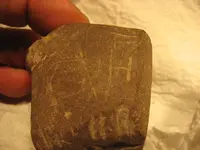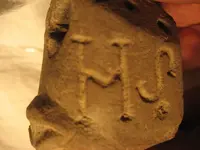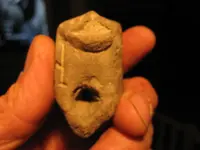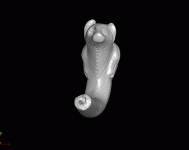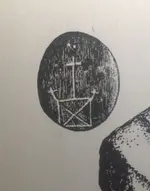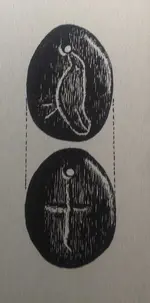How can you be sure its Indian in origin? Does it match the manufacturing style of known Native American pipes in your area?
I'm just wondering why could it not be colonial made... it has colonial letters...and Reed pipes were a colonial item.
Did the college comment on the pipe itself?
Did they belive it to be a Calumet? "Peace pipe"
I believe the various Iroquois tribes produced more effigy pipes beginning Late Prehistoric then any other group in the northeast US. Very well known for effigy pipes in general. A colonial is also not likely to place a cross on the backside. Given the history of the strong influence of Jesuit missionaries in what is now New York State in the 16th and 17th centuries, that's almost surely a native mark, not Colonial. As is the effigy form. As is the style of pipe, a bowl pipe. That seems clearly Native American. I just cannot imagine a colonist carving a Native American style pipe, and then putting a cross on the back to denote his faith. If that's what it does denote, that is. But a Christianized native might do just that, put a cross on the pipe. Iroquois sites in NYS are "littered" with Jesuit trade rings bearing the cross.
just saw your last comment. Sure, initials could have been added later, could have been found and added to. The initials do look "fresher", but my own experience with steatite is that can be a real tough thing to judge. On a lot of my steatite sherds, the scraping marks from manufacturing are lighter then the host piece. The manufacturing marks can look pretty fresh. Steatite is weird that way, in my experience, and IMO. No doubting the European style of the lettering. The Jesuits did educate the natives, as well as convert, which was the foremost goal for the Jesuits.
"I wonder what the chances are that a fur trapper made a pipe out of local steatite.
I can't see a native pipe of importance being left in that state of completion.
The head looks to me like a Fisher.
A very lucrative fur animal in the fur trapping industry of the northeast.
Most of the farm land there was forest before it was logged and cleared for farming."
It's a great pipe, but effigy pipes that are complete are found all the time, as is most every other class of artifact.
it might have been important to the individual, but what is a "native pipe of importance"? I don't think we need to invoke, for instance, that it had to belong to a sachem or was of tribal wide importance. Lots and lots of completed soapstone effigy pipes found here in the Northeast. Just not enough so we can all own a real one for 20 bucks. LOL. It's always possible a Frenchman gone native could carve such a pipe for himself, but the path of least resistance probably remains native simply because the style is so common in the Northeast, except for those letters but of course.
Here are 2 pendants from Maine, from a village site that saw French Jesuit missionaries for decades.
 Attached Thumbnails
Attached Thumbnails







